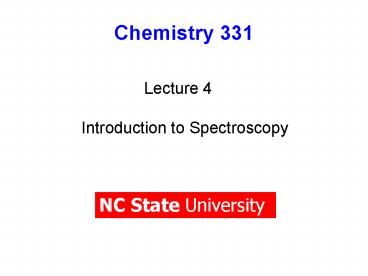Spectroscopy - PowerPoint PPT Presentation
1 / 23
Title:
Spectroscopy
Description:
The origin of spectral lines in molecular. spectroscopy is the ... Dispersing element is in the spectrograph. Comparison of sample and reference is essential ... – PowerPoint PPT presentation
Number of Views:42
Avg rating:3.0/5.0
Title: Spectroscopy
1
Chemistry 331
Lecture 4 Introduction to Spectroscopy
NC State University
2
Spectroscopy
- Electromagnetic radiation
- Dipole moment
- Transition moment
- Selection rules
- Experimental techniques
- Intensities
The origin of spectral lines in molecular
spectroscopy is the emission or absorption of a
photon when the energy of a molecule changes.
3
Characteristics of
electromagnetic radiation
Electromagnetic radiation can be described as a
wave with an oscillating electric field. Light
can be linearly polarized along the x, y, or z
axes. The electric field vector is to the
direction of propagation.
E electric field B magnetic field
E Eocos(2pnt)
4
Basic Phenomena
Emission spectroscopy - a molecule undergoes a
transition from a state of high energy E1 to a
state of lower energy E2 and emits the excess
energy as a photon. Absorption spectroscopy
the energy of an incident photon drives a
polarization from the molecular ground state to
the excited state. An absorbed photon has a
frequency given by the Bohr relation hn E1
E2
5
Definition of the Dipole Moment
The dipole moment operator is
where zie is the electronic charge at a nucleus
and ri is a vector from an arbitrary origin.
Along the x-direction
6
Examples of ground state dipole
moments
The ground state dipole moment of hydrogen
halides can be calculated from the fractional
charges
1 Debye 3.33 x 10-30 Cm
d d- R(pm) m(x 10-30 Cm) HF 0.42 0.42 91.7
6.37 1.9 D HCl 0.16 0.16 127.5 3.44 1.0
D HBr 0.11 0.11 141.4 2.64 0.8
D HI 0.05 0.05 160.9 1.40 0.4 D
7
Definition of the transition dipole
moment
The transition dipole moment results from the
interaction of electromagnetic radiation with the
molecule where E E0cos(2pnt) and the
hamiltonian for interaction is
where mx is the transition dipole moment
8
Selection Rules
A transition will be allowed only if the
transition dipole moment integral is non-zero.
The general rules are Electronic Dl 1, Dm
0 Rotational DJ 1, DM 0 Vibrational
Dv 1 For mathematical description see
the workshop on selection rules.
9
Sources of Radiation
- Nerst filament infrared
- Arc lamp (Xe) UV-vis
- Tungsten-halogen visible near-IR
- Lasers
- Excimer
- Ion
- YAG
- Tisapphire
10
Dispersion is essential
- A dispersing element separates different
frequencies into different spatial directions. - A prism separates different frequencies because
of the optical beam using the variation of the
index of refraction such that high-frequency
radiation undergoes a greater deflection than
low-frequency radiation. - A diffraction grating consists of grooves cut ca.
1 mm apart. Interference from reflected waves
gives rise to specific angles of propagation.
11
Detectors
- Thermistor bolometer, far ir
- Mercury Cadmium Telluride (MCT), ir
- Germanium, near ir
- Silicon, visible
- Photomultiplier tube. Amplification by dynodes
generates current for each photon hit. - CCD detector. Array of detectors on a chip. UV
coatings, efficiency, ease of use.
12
Absorption Spectrometer
Dispersing element is in the spectrograph
Light Source
Comparison of sample and reference is essential
13
Intensities of Spectral Lines
- Intensity of absorption for a sample that has
thickness d is given by - e is the molar absorption coefficient.
- c is the concentration.
- d is the pathlength.
- I is the transmitted intensity, I0 is the
incident intensity.
14
Beer-Lambert Law
A is the absorbance. d is the pathlength. The
exponential attenuation of the intensity is
shown in the Figure. The absorption cross
section for an individual molecule is s. s
hnk12 where k12 is the transition rate constant.
x
x
dx
I0
I
I
IdI
d
15
Theory of Absorption and Emission
- Stimulated absorption - low to high driven by
absorption of a photon - Stimulated emission - high to low driven by
emission of a photon - Spontaneous emission - high to low emission
independent of photon field - Einstein coefficients
- B12 - stimulated absorption
- B21 - stimulated emission
- A21 - spontaneous emission
16
Spontaneous emission is fluorescenceStimulated
emission is used for lasers
spontaneous
stimulated
N1B12r
N2A21
N2B21r
17
Einsteins derivation of absorption and
emission coefficients
- Absorption w12 B12r, Emission w21 (A21B21r)
- for individual molecules.
- The total rates of absorption and emission
- W N1w12 where N1 is the number in the
ground state - W N2w21 where N2 is the number in the
excited state - Thermal equilibrium demands that
- W W i.e. N1B12r N2(A21B21r)
- The derivation consists of solving for r and
noticing the similarity with Planck distribution.
18
Treatment of states in equilibrium
19
Comparison with Plancks
blackbody distribution
The equation for the radiation density, r has
the same form as the Planck distribution
provided,
The Planck distribution is
20
Interpretation of Einstein Coefficients
The intrinsic coefficient for absorption B12 is
related to k12 NB12r, where r is the energy
density Einstein showed that the rate of
absorption and stimulated emission are equal.
The spontaneous emission rate has a definite
relation to the stimulated emission rate
21
The transition probability is proportional to
the square of the transition moment
The absorption of radiation involves
time-dependence because the field is time-varying
E0sin(2pnt). If we solve for the transition
probability we find that it is proportional to
the square of transition moment.
22
Connection with experiment
Beers law states that
e(n) is the molar extinction coefficient. c is
the concentration. d is the pathlength. In
differential form this is written
A comparable expression in terms of the
individual transition rates is given by
23
Experimental determination of the transition
moment by absorption spectroscopy
The transition moment is related to the
integrated extinction coefficient.































